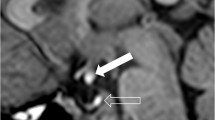Abstract
The computed tomography and MRI imaging findings in a case of pituitary duplication and epipharyngeal teratoma are described in a newborn baby girl with respiratory difficulties. Associated skull base and central nervous system malformations are presented. Teratoma diagnosis was confirmed by histology. The embryological pathogenesis is discussed.





Similar content being viewed by others
References
Bagherian V, Graham M, Gerson LP, Amstrong DL (1984) Double pituitary glands with partial duplication of facial and brain structures with hydrocephalus. Comput Radiol 8:203–210
Bainborogh AR, Hase S (1958) Double hypophysis. Can Med Assoc J 79:912–913
Bale PM, Reye RD (1976) Epignathus, double pituitary and agenesis of corpus callosum. J Pathol 120:161–164
Burke M, Zinkovsky S, Abrantes M, Riley W (2000) Duplication of the hypophysis. Pediatr Neurosurg 33:95–99
Hamon-Kerautret M, Ares GS, Demondion X, Rouland V, Francke J-P, Pruvo J-P (1998) Duplication of the pituitary gland in a newborn with median cleft face syndrome and nasal teratoma. Pediatr Radiol 28:290–292
Hori A (1983) A brain with two hypophyses in median cleft face syndrome. Acta Neuropathol 59:150–154
Il’Ina EG, Laziuk GI (1989) A new case of the “double hypophysis-multiple congenital developmental defects” complex. Tsitol Genet 23:45–46
Kollias SS, Ball WS, Prenger EC (1995) Review of the embryologic development of the pituitary gland and report of a case hypophyseal duplication detected by MRI. Neuroradiology 37:3–12
Morton WRM (1957) Duplication of the pituitary and stomatodaeal structures in a 38-week male infant. Arch Dis Child 32:135–141
Roesmann U (1985) Duplication of the pituitary gland and spinal cord. Arch Pathol Lab Med 109:518–520
Ryals BD, Brown DC, Levin SW (1993) Duplication of the pituitary gland as shown by MR. AJNR Am J Neuroradiol 14:137–139
Shah S, Pereira JK, Becker CJ, Roubal SE (1997) Duplication of pituitary gland. J Comput Assist Tomogr 21:459–461
Shroff M, Blase S, Jay V, Chitayat D, Armstrong D (2003) Basilar artery duplication associated with pituitary duplication: a new finding. AJNR Am J Neuroradiol 24:956–961
Tagliavini F, Pilleri G (1986) Mammillo-hypophyseal duplication (diplo-mammillo-hypophysis). Acta Neuropathol 69:38–44
Uchino A, Sawada A, Takase Y, Fujita I, Kudo S (2002) Extreme fenestration of the basilar artery associated with cleft palate, nasopharyngeal mature teratoma, and hypophyseal duplication. Eur Radiol 12:2087–2090
Author information
Authors and Affiliations
Corresponding author
Rights and permissions
About this article
Cite this article
Huisman, T.A.G.M., Fischer, U., Boltshauser, E. et al. Pituitary duplication and nasopharyngeal teratoma in a newborn: CT, MRI, US and correlative histopathological findings. Neuroradiology 47, 558–561 (2005). https://doi.org/10.1007/s00234-005-1374-8
Received:
Accepted:
Published:
Issue Date:
DOI: https://doi.org/10.1007/s00234-005-1374-8




